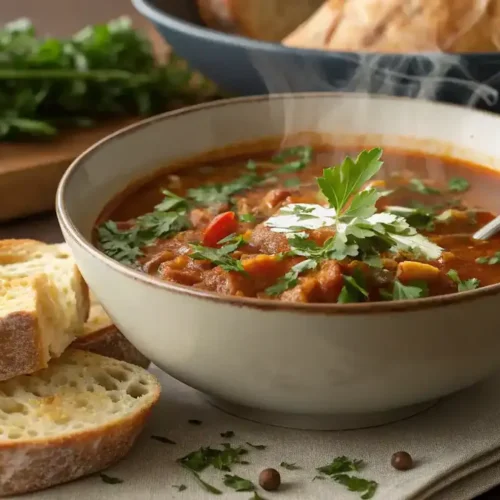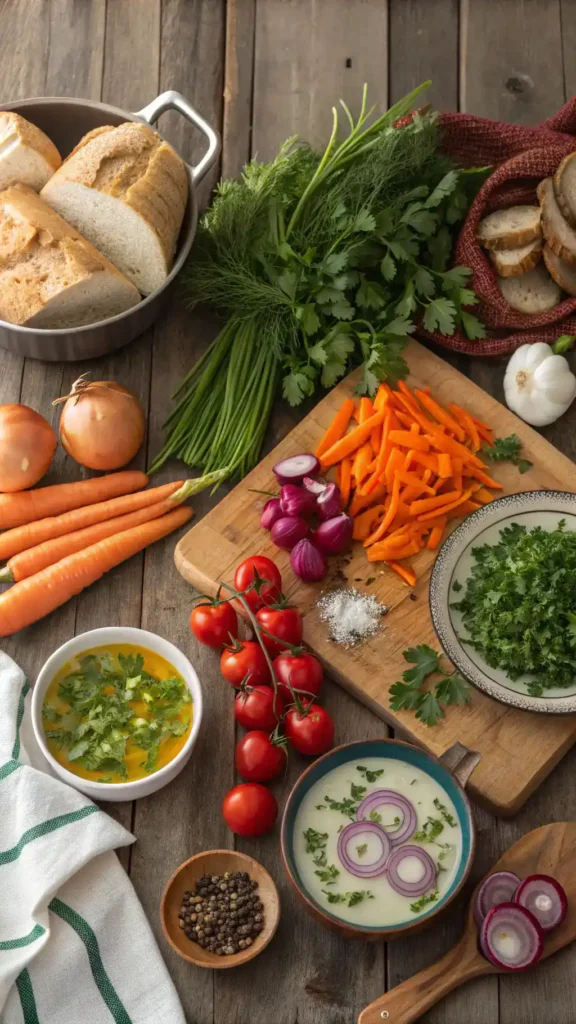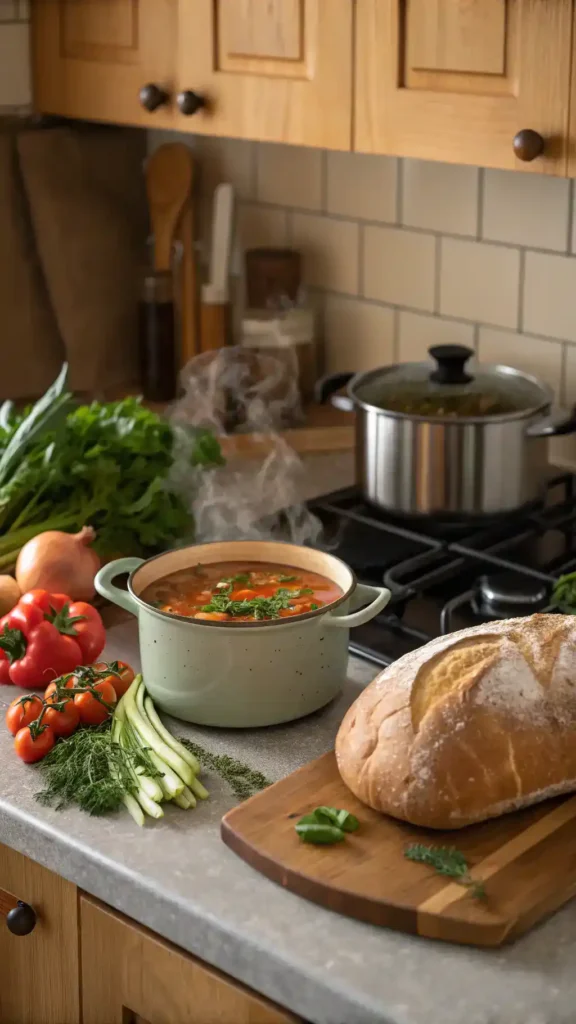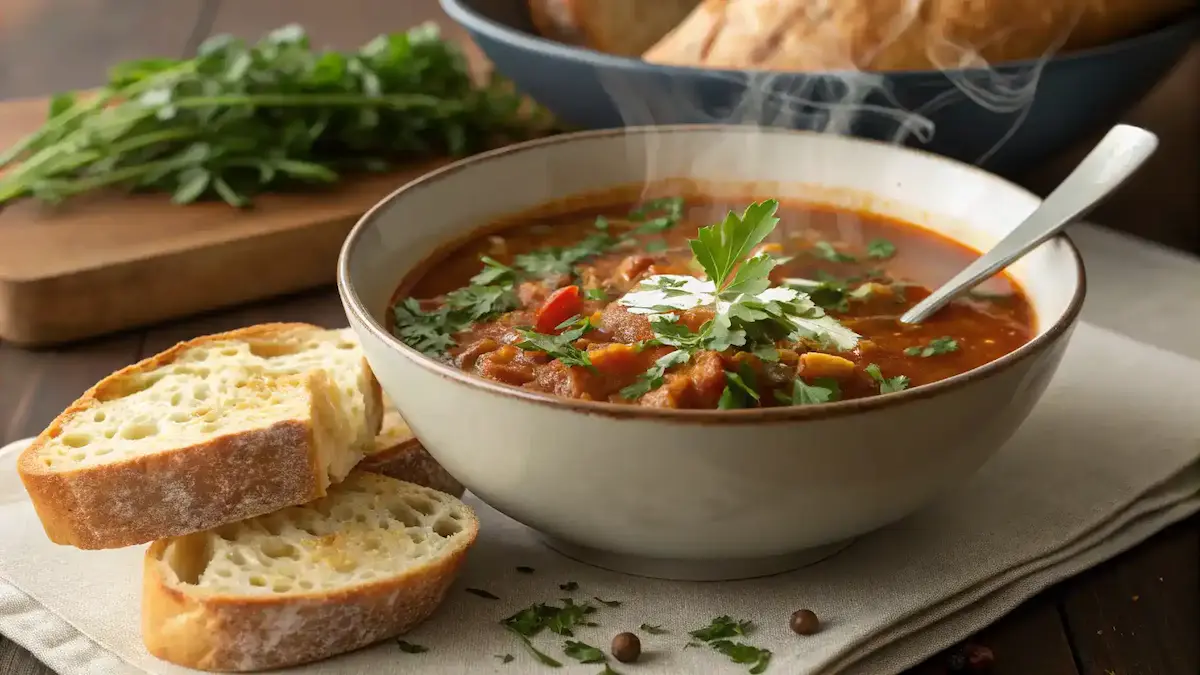There’s something undeniably comforting about a warm bowl of soup and a slice of freshly baked bread. This classic duo not only warms the soul but also nourishes the body. Whether you’re enjoying a creamy tomato soup or a hearty vegetable stew, pairing it with crusty artisan bread elevates the experience. In fact, the combination of soup and bread creates a satisfying meal that balances flavors and textures beautifully. So, if you’re ready to embark on a culinary adventure, let’s dive into the delightful world of soup and bread!
Table of Contents
Table of Contents

soup and bread
Equipment
- 1 Large Pot For cooking the soup.
- 1 Mixing Bowl For preparing the bread dough.
- 1 Baking sheet For baking the bread.
Ingredients
Fresh Vegetables
- 2 cups Carrots Chopped.
- 1 cup Celery Chopped.
- 1 cup Onions Chopped.
Broth
- 4 cups Vegetable or Chicken Broth For the soup base.
Herbs and Spices
- 1 tablespoon Garlic Minced.
- 1 teaspoon Pepper To taste.
Whole Grain Bread
- 3 cups Whole Wheat Flour For the bread.
- 1 packet Yeast Active dry yeast.
- 1 cup Warm Water For activating the yeast.
- 1 teaspoon Salt For flavor.
Dairy Alternatives
- 1 cup Almond Milk For a creamy texture.
Toppings
- to taste Fresh Herbs or Cheese For garnishing the soup.
Instructions
Gather Your Ingredients
- Start by collecting all the necessary ingredients for both the soup and the bread. For the soup, you’ll need fresh vegetables, vegetable broth, herbs, and spices. For the bread, gather flour, yeast, water, and salt. Having everything ready will make the process smoother.
Prepare the Soup Base
- In a large pot, heat a tablespoon of olive oil over medium heat. Add chopped onions, garlic, and any other vegetables you like. Sauté them until they are soft and fragrant, which usually takes about 5 minutes.
Add Broth and Simmer
- Pour in your vegetable broth and bring it to a gentle boil. Once boiling, reduce the heat and let it simmer for about 20 minutes. This allows the flavors to meld beautifully.
Season to Taste
- After simmering, taste your soup. Add herbs like basil or thyme, and season with salt and pepper. Adjust the flavors according to your preference, ensuring a satisfying taste balance.
Prepare the Bread Dough
- While your soup is simmering, it’s time to make the bread. In a mixing bowl, combine flour, yeast, and salt. Gradually add warm water, mixing until a dough forms. If you prefer whole grain or gluten-free options, feel free to substitute accordingly.
Knead the Dough
- Transfer the dough to a floured surface. Knead it for about 10 minutes until it becomes smooth and elastic. This step is crucial for developing the bread’s texture.
Let It Rise
- Place the kneaded dough in a greased bowl, cover it with a damp cloth, and let it rise in a warm place for about an hour. The dough should double in size, which is essential for a fluffy bread.
Shape and Bake the Bread
- Once risen, punch down the dough to release air. Shape it into a loaf or rolls, then place it on a baking sheet. Let it rise again for about 30 minutes. Preheat your oven to 375°F (190°C) and bake the bread for 25-30 minutes until golden brown.
Serve and Enjoy
- Once your bread is baked and your soup is ready, it’s time to serve! Ladle the soup into bowls and slice the warm bread. You can add toppings like fresh herbs or cheese to the soup for extra flavor. Enjoy the warmth and satisfaction of this classic pairing!
Notes
Key Benefits of Soup and Bread
When it comes to comfort food, few pairings can rival the delightful combination of soup and bread. This classic duo not only warms the soul but also offers a plethora of health benefits. Here’s why you should indulge in this wholesome pairing:
- Rich in Nutritional Value: Soup is often packed with fresh vegetables, lean proteins, and wholesome grains. Consequently, it provides essential vitamins and minerals that support overall health. When paired with bread, especially whole grain varieties, you enhance the meal’s fiber content, promoting digestive health.
- Hearty Meal Satisfaction: There’s something undeniably satisfying about a warm bowl of soup accompanied by a slice of crusty bread. This combination not only fills you up but also keeps you feeling satisfied for longer, reducing the temptation for unhealthy snacks later.
- Warmth and Comfort: On chilly days, nothing beats the warmth of soup and bread. This pairing not only nourishes the body but also soothes the mind, making it a perfect choice for cozy evenings at home.
- Flavor Balance: The taste balance between a savory soup and a hearty bread creates a delightful culinary experience. For example, a creamy tomato soup pairs beautifully with a tangy sourdough, enhancing both flavors and textures.
- Versatile Pairings: Soup and bread can be customized to suit any palate. Whether you prefer a spicy lentil soup with whole grain bread or a classic chicken noodle with a buttery roll, the options are endless. This versatility makes it easy to adapt to dietary preferences and seasonal ingredients.
In summary, enjoying soup and bread together not only satisfies your taste buds but also nourishes your body. So, the next time you’re looking for a comforting meal, remember the incredible benefits of this timeless pairing!
Ingredients for a Wholesome Soup and Bread
Creating the perfect pairing of soup and bread starts with selecting fresh, nourishing ingredients. Here’s a list of essentials that not only enhance flavor but also contribute to your health:
- Fresh Vegetables: Carrots, celery, and onions form the aromatic base of many soups. They are rich in vitamins A and C, promoting a healthy immune system.
- Broth: Choose vegetable or chicken broth for a flavorful foundation. Broth is hydrating and can be low in calories, making it a great choice for a hearty meal.
- Herbs: Fresh herbs like basil and thyme add depth to your soup. They are packed with antioxidants and can help reduce inflammation.
- Spices: Garlic and pepper not only enhance taste but also offer health benefits. Garlic is known for its immune-boosting properties, while pepper can aid digestion.
- Whole Grain Bread: Opt for whole wheat or sourdough for a fiber-rich option. Whole grains support heart health and provide lasting energy.
- Gluten-Free Options: If you prefer gluten-free bread, look for options made with almond or coconut flour. These alternatives are often lower in carbs and high in healthy fats.
- Dairy Alternatives: For a creamy texture without dairy, consider using almond milk or coconut cream. These options are often lower in calories and can be easier to digest.
- Toppings: Garnish your soup with fresh herbs or a sprinkle of cheese for added flavor. These toppings can elevate your dish and provide extra nutrients.

By carefully selecting these ingredients, you not only create a delicious soup and bread combination but also ensure a meal that is comforting and health-conscious. Enjoy the process of cooking, and remember that each ingredient contributes to the warmth and satisfaction of your homemade soup and bread.
How to Make Soup and Bread
Creating a comforting bowl of soup and a warm loaf of bread is a delightful culinary adventure. Follow these simple steps to make your own delicious soup and bread from scratch. This beginner-friendly guide will ensure you enjoy the process as much as the outcome!
- Gather Your Ingredients: Start by collecting all the necessary ingredients for both the soup and the bread. For the soup, you’ll need fresh vegetables, vegetable broth, herbs, and spices. For the bread, gather flour, yeast, water, and salt. Having everything ready will make the process smoother.
- Prepare the Soup Base: In a large pot, heat a tablespoon of olive oil over medium heat. Add chopped onions, garlic, and any other vegetables you like. Sauté them until they are soft and fragrant, which usually takes about 5 minutes.
- Add Broth and Simmer: Pour in your vegetable broth and bring it to a gentle boil. Once boiling, reduce the heat and let it simmer for about 20 minutes. This allows the flavors to meld beautifully.
- Season to Taste: After simmering, taste your soup. Add herbs like basil or thyme, and season with salt and pepper. Adjust the flavors according to your preference, ensuring a satisfying taste balance.
- Prepare the Bread Dough: While your soup is simmering, it’s time to make the bread. In a mixing bowl, combine flour, yeast, and salt. Gradually add warm water, mixing until a dough forms. If you prefer whole grain or gluten-free options, feel free to substitute accordingly.
- Knead the Dough: Transfer the dough to a floured surface. Knead it for about 10 minutes until it becomes smooth and elastic. This step is crucial for developing the bread’s texture.
- Let It Rise: Place the kneaded dough in a greased bowl, cover it with a damp cloth, and let it rise in a warm place for about an hour. The dough should double in size, which is essential for a fluffy bread.
- Shape and Bake the Bread: Once risen, punch down the dough to release air. Shape it into a loaf or rolls, then place it on a baking sheet. Let it rise again for about 30 minutes. Preheat your oven to 375°F (190°C) and bake the bread for 25-30 minutes until golden brown.
- Serve and Enjoy: Once your bread is baked and your soup is ready, it’s time to serve! Ladle the soup into bowls and slice the warm bread. You can add toppings like fresh herbs or cheese to the soup for extra flavor. Enjoy the warmth and satisfaction of this classic pairing!

Making soup and bread is not only about the final dish but also about the joy of cooking. So, gather your loved ones, and share this comforting meal together!
Pro Tips, Variations, and Common Problems for Soup and Bread
Making the perfect soup and bread pairing can be a delightful culinary adventure. Here are some expert tips and variations to elevate your experience, along with solutions to common problems you might encounter.
Pro Tips
– Always start with a good base. For soups, use homemade or high-quality broth. This enhances the flavor significantly. Additionally, consider roasting your vegetables before adding them to the soup for a deeper taste.
– When making bread, ensure your yeast is fresh. If your bread doesn’t rise, it could be due to expired yeast. To test it, mix yeast with warm water and a pinch of sugar; it should foam within 10 minutes.
– For a creamier soup, blend a portion of it after cooking. This technique adds a velvety texture without the need for heavy cream. Moreover, you can add a splash of coconut milk or a dollop of yogurt for extra richness.
Variations
– Experiment with different types of bread! Sourdough, whole wheat, or even gluten-free options can complement your soup beautifully. For instance, a hearty lentil soup pairs wonderfully with crusty whole grain bread.
– Try seasonal ingredients in your soup. In the fall, add pumpkin or squash; in the summer, fresh tomatoes and basil can brighten your dish. Consequently, this keeps your meals exciting and fresh.
– Consider adding spices to your bread dough, such as rosemary or garlic powder, to enhance flavor. This small adjustment can make a big difference in your overall dish.
Common Problems and Solutions
– If your soup is too salty, add a peeled potato while it simmers. The potato absorbs excess salt, balancing the flavor. Alternatively, you can dilute it with more broth or water.
– For bread that doesn’t rise, check your kneading technique. Knead until the dough is smooth and elastic. If it’s too dry, add a bit of water; if too wet, sprinkle in some flour gradually.
– If your bread has a dense texture, it may be due to over-kneading or not allowing it to rise long enough. Ensure you give it ample time to double in size before baking.
By following these tips and variations, you can create a comforting and satisfying soup and bread experience. Remember, cooking is all about experimentation, so don’t hesitate to make it your own!
Serving Suggestions for Soup and Bread
Soup and bread create a delightful pairing that warms the heart and satisfies the soul. Whether you’re hosting a cozy gathering or enjoying a quiet evening at home, this classic duo fits perfectly into various occasions. Here are some engaging serving suggestions to elevate your soup and bread experience:
Occasions to Enjoy
Consider these moments when serving soup and bread:
- Family Dinners: A comforting bowl of soup and a slice of fresh bread can bring everyone together around the table.
- Casual Gatherings: Perfect for a laid-back get-together with friends, where everyone can enjoy dipping and sharing.
- Seasonal Celebrations: Serve hearty soups during fall and winter holidays for a festive touch that warms guests from the inside out.
- Lunch Breaks: A quick, nutritious meal that can be enjoyed at home or packed for work, making it a versatile option.
Presentation Ideas
To make your soup and bread visually appealing, consider these tips:
- Garnishes: A sprinkle of fresh herbs, such as parsley or chives, can add a pop of color and freshness to your soup.
- Serving Bowls: Use rustic bowls for a homey feel or elegant dishes for a more refined presentation.
- Accompaniments: Pair your soup with a side salad or a platter of assorted crackers to enhance the meal.
- Cheese Toppings: A sprinkle of grated cheese, like cheddar or feta, can add richness and flavor to your soup.
Pairing Ideas
Enhance your soup and bread experience with these delightful pairings:
- Herb-Infused Butter: Spread a little herb-infused butter on warm bread for an extra layer of flavor.
- Spicy Dips: Serve a spicy dip alongside your bread for those who enjoy a kick.
- Seasonal Vegetables: Add roasted or grilled seasonal vegetables as a side to complement the soup’s flavors.
- Fruit Chutneys: A sweet fruit chutney can balance the savory notes of your soup beautifully.
Ultimately, the joy of soup and bread lies not only in their comforting flavors but also in the memories created around the table. So, gather your loved ones, serve this delightful pairing, and enjoy the warmth it brings to every occasion.
How to Properly Store and Reheat Soup and Bread
Storing and reheating soup and bread properly is essential to maintain their delightful flavors and textures. Here’s how to do it like a pro!
Storage Tips
To keep your soup and bread fresh, start by using airtight containers. For soup, allow it to cool completely before transferring it to a container. Refrigerate it for up to 3-4 days. If you want to store it longer, consider freezing it in freezer-safe bags or containers. Soup can last up to 3 months in the freezer.
For bread, wrap it tightly in plastic wrap or aluminum foil, and store it in a cool, dry place. If you plan to keep it for more than a few days, freezing is your best option; bread can stay fresh for up to 3 months in the freezer as well. Always label your containers with the date to keep track of freshness. Additionally, remember to avoid leaving food out at room temperature for more than 2 hours to prevent bacterial growth.
Reheating Methods
When it comes to reheating soup and bread, there are several effective methods to ensure they retain their delicious qualities. For soup, the stovetop is a great option. Simply pour the soup into a pot, add a splash of water or broth to refresh it, and heat over medium-low heat, stirring occasionally until warmed through. Alternatively, you can use the microwave; transfer the soup to a microwave-safe bowl, cover it loosely, and heat in 30-second intervals, stirring in between, until hot.
For bread, the oven is ideal. Preheat it to 350°F (175°C), wrap the bread in foil to prevent it from drying out, and heat for about 10-15 minutes. If you’re short on time, the microwave works too; just place the bread on a microwave-safe plate, cover it with a damp paper towel, and heat for 10-15 seconds. This method helps maintain moisture. Lastly, if you have an air fryer, you can reheat bread at 300°F (150°C) for about 5 minutes for a crispy crust. By following these tips, you can enjoy your soup and bread just as much as when they were freshly made!
Conclusion
In summary, this soup and bread recipe is not just a meal; it’s a comforting experience that brings warmth and satisfaction to your table. The simplicity and versatility of this pairing make it an excellent choice for both novice cooks and seasoned chefs alike. Whether you opt for a hearty vegetable soup or a creamy bisque, paired with your favorite bread, you’re sure to create a delightful dish that nourishes both body and soul. So, I encourage you to roll up your sleeves and dive into this culinary adventure. You’ll find joy in the process and pride in the delicious results!
Share Your Experience
I would love to hear how your soup and bread turned out! Feel free to share your results or ask any questions you may have. Additionally, don’t hesitate to experiment with different ingredients or flavor combinations to make this dish your own. Cooking is all about creativity and fun, and this classic pairing is a perfect canvas for your culinary imagination. Remember, every bowl of soup and slice of bread is an opportunity to explore new tastes and textures, so enjoy the journey!
Frequently Asked Questions About Soup and Bread
Here are some common questions you might have about making and enjoying soup and bread. We hope these answers help you create the perfect pairing!
1. What are the best types of bread to serve with soup?
When it comes to pairing bread with soup, crusty artisan bread, sourdough, and whole grain options are fantastic choices. They not only complement the flavors of the soup but also provide a satisfying texture. Additionally, consider trying garlic bread or even a warm baguette for a delightful twist!
2. How can I thicken my soup?
If your soup is too thin, there are several ways to thicken it. You can blend a portion of the soup and stir it back in, add a slurry of cornstarch and water, or incorporate mashed potatoes or pureed beans. Each method enhances the soup’s texture while maintaining its flavor.
3. Can I freeze leftover soup and bread?
Absolutely! To freeze soup, let it cool completely, then store it in airtight containers. For bread, wrap it tightly in plastic wrap and place it in a freezer bag. When you’re ready to enjoy them, simply thaw the soup in the refrigerator overnight and reheat it on the stove. For bread, you can toast it directly from frozen for a crispy finish!
4. What are some healthy soup and bread options?
For a healthier twist, opt for vegetable-based soups packed with fresh vegetables and lean proteins. Pair them with whole grain or gluten-free bread for a nutritious meal. Additionally, consider adding herbs and spices to enhance flavor without extra calories!
5. How do I prevent my bread from getting stale?
To keep your bread fresh, store it in a cool, dry place in a paper bag or a bread box. Avoid plastic bags, as they can trap moisture and lead to mold. If you have leftover bread, consider freezing it for longer storage. Just remember to slice it before freezing for easy use later!

